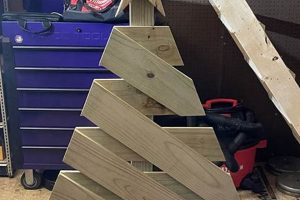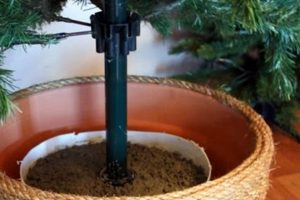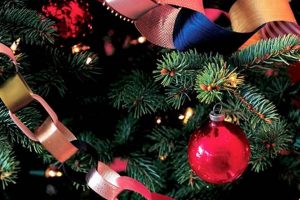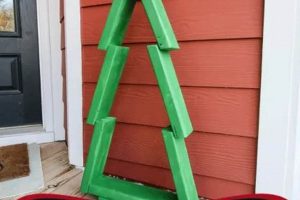The process involves applying a powdery substance, typically made of synthetic fibers or cellulose, to the branches of a Christmas tree to mimic the appearance of fresh snow. This decorative technique allows for customization of the tree’s aesthetic, ranging from a light dusting to a heavy, snow-laden effect. It can be applied to both artificial and real trees, offering a visually striking alternative to traditional undecorated trees.
The creation of a snow-covered appearance on a Christmas tree offers advantages, including enhancing the tree’s visual appeal and creating a festive winter atmosphere within a home. This method also provides a cost-effective way to repurpose older or less aesthetically pleasing trees, transforming them into centerpieces. Historically, the desire to replicate natural winter landscapes indoors has driven the adoption of similar decorative techniques.
The subsequent sections will detail materials selection, the application process, safety considerations, and techniques for achieving various levels of coverage, ensuring a successful and visually appealing outcome. This guide aims to provide the information necessary for executing this project effectively.
Essential Guidance for a Snow-Kissed Christmas Tree
The following are crucial recommendations for successfully achieving a visually appealing, self-applied snow effect on a Christmas tree. Attention to these details will ensure a professional-looking result and a durable finish.
Tip 1: Select Appropriate Flocking Material: Opt for commercially available flocking powder designed specifically for Christmas trees. These products are typically non-toxic and formulated for optimal adhesion and appearance. Avoid using alternative materials, as they may pose safety risks or produce undesirable results.
Tip 2: Ensure Adequate Ventilation: Conduct the flocking process in a well-ventilated area, ideally outdoors or in a garage with open doors. This will minimize the inhalation of airborne particles. Wearing a dust mask is also highly recommended for respiratory protection.
Tip 3: Prepare the Tree Thoroughly: Before applying the flocking material, remove any loose needles or debris from the tree. This will create a cleaner surface and improve the adhesion of the flocking. If using an artificial tree, ensure it is clean and dry.
Tip 4: Use a Consistent Spraying Technique: Apply the adhesive and flocking powder in thin, even layers, maintaining a consistent distance from the tree. This will prevent clumping and ensure a uniform appearance. Overlapping layers is preferable to applying thick, uneven coats.
Tip 5: Allow Sufficient Drying Time: After applying the flocking, allow the tree to dry completely before decorating it. This typically takes 24-48 hours, depending on the humidity and temperature. Rushing the drying process can result in the flocking becoming dislodged.
Tip 6: Consider Tree Support: The added weight of the flocking material can make the tree less stable. Ensure the tree stand is sturdy and appropriately sized for the tree’s height and weight. Consider adding additional support if necessary.
Tip 7: Practice on a Small Section First: Before committing to the entire tree, test the flocking technique on a small, inconspicuous section. This will allow for adjustments to the spraying technique and material application, minimizing potential errors on the main tree.
Proper execution yields a striking visual transformation, imbuing the tree with an elegant, wintry aesthetic. Adhering to these insights enhances the likelihood of a successful and aesthetically pleasing result.
The subsequent sections will address safety precautions, cleaning methodologies, and long-term storage considerations associated with the finished article.
1. Materials Selection
The efficacy and aesthetic quality of a self-applied snow effect on a Christmas tree are directly contingent upon the careful selection of appropriate materials. The composition, adhesion properties, and safety characteristics of these materials significantly impact the final result.
- Flocking Material Composition
The primary flocking material typically consists of synthetic fibers, cellulose, or a combination thereof. The choice between these materials influences the texture, appearance, and environmental impact of the finished product. Synthetic fibers often provide a brighter white and better water resistance, while cellulose-based flocking may offer a more natural appearance and is generally considered more biodegradable. The grain size of the flocking material also affects the overall texture, with finer grains producing a smoother, more delicate snow-like effect.
- Adhesive Properties and Compatibility
The adhesive serves as the binding agent between the flocking material and the tree branches. The selected adhesive must exhibit strong bonding capabilities, be compatible with both the flocking material and the tree type (real or artificial), and remain pliable after drying to prevent cracking or flaking. Water-based adhesives are commonly preferred due to their lower VOC (Volatile Organic Compounds) content and ease of cleanup. The adhesive’s drying time and transparency are also critical factors to consider.
- Safety and Toxicity Considerations
When modifying a Christmas tree, it is essential to prioritize the safety and well-being of individuals and pets within the environment. Select flocking and adhesive products that are explicitly labeled as non-toxic, low-odor, and VOC-compliant. Review the product’s Material Safety Data Sheet (MSDS) to understand potential hazards and ensure proper ventilation during application. The use of materials containing harmful chemicals can pose health risks and negatively impact indoor air quality.
- Application Equipment Considerations
The method of application influences the material selection. Professional sprayers are an option but involve higher costs and setup. Simpler options such as pump sprayers, or even sifting, will influence the choice of flocking material and adhesive. Using a sifter will typically require a slower drying adhesive to maximize bond strength as the flocking is applied dry.
The successful creation of a snow-covered Christmas tree necessitates a comprehensive understanding of the materials involved. The composition of the flocking, the properties of the adhesive, and adherence to safety regulations collectively determine the visual impact, durability, and safety of the finished piece. A measured and deliberate selection approach will contribute significantly to achieving a professional and aesthetically pleasing result.
2. Application Technique
The process of achieving a self-applied snow effect on a Christmas tree is significantly influenced by the application technique employed. The consistency, uniformity, and durability of the finish depend directly on the method used to apply both the adhesive and the flocking material.
- Spraying Method and Equipment
The application of flocking typically involves spraying the adhesive onto the tree branches, followed by the application of the flocking material while the adhesive is still wet. The type of sprayer used, whether a pneumatic sprayer, a pump sprayer, or an electrostatic sprayer, influences the distribution and adhesion of the flocking. Pneumatic sprayers offer greater control and a finer mist, resulting in a more uniform application. Pump sprayers are a more economical option but may require more passes to achieve adequate coverage. Electrostatic sprayers charge the flocking particles, enhancing their attraction to the tree branches and minimizing overspray.
- Layering and Coverage Control
The layering technique employed directly affects the overall appearance. Multiple thin layers are preferable to a single thick layer. This approach promotes even distribution and reduces the likelihood of clumping or sagging. Controlling the coverage involves adjusting the spray pattern, distance from the tree, and application speed. Concentrating on specific areas, such as the tips of the branches, can create a more natural, snow-covered effect. Conversely, applying a light dusting to the entire tree provides a subtle, wintry aesthetic.
- Adhesive Application Consistency
The consistency of the adhesive application is crucial for ensuring optimal flocking adhesion. Applying the adhesive too thinly may result in inadequate bonding, causing the flocking to flake off over time. Applying the adhesive too thickly can lead to dripping and an uneven texture. Maintaining a consistent spray pattern and adjusting the adhesive viscosity as needed ensures a uniform and durable bond between the flocking and the tree branches.
- Environmental Factors During Application
External conditions, such as temperature and humidity, significantly influence the application process. High humidity levels can impede the drying process of the adhesive, potentially leading to clumping or sagging of the flocking material. Low temperatures can reduce the adhesive’s tackiness, diminishing its bonding strength. Optimizing the application environment, by controlling humidity levels and maintaining a moderate temperature, enhances the likelihood of a successful and durable finish.
The application technique constitutes a critical component in the process of self-applying a snow effect on a Christmas tree. Skillful manipulation of spraying methods, layering strategies, adhesive consistency, and environmental considerations significantly contributes to the creation of a visually appealing and enduring decorative piece.
3. Coverage Consistency
Achieving a uniform appearance is paramount in a do-it-yourself snow-covered Christmas tree. Inconsistent application of flocking material detracts from the desired aesthetic, creating a patchy or uneven look. Therefore, maintaining consistent coverage is a critical factor for the overall success of this project.
- Uniform Density of Flocking
Maintaining a consistent density of flocking across all tree branches is essential for visual harmony. Variations in density create distracting focal points and undermine the illusion of natural snow accumulation. For example, a branch with heavy flocking placed next to a sparsely covered branch appears artificial. Consistent density requires careful attention to spray technique and material distribution during application.
- Even Distribution on Branch Structures
The flocking material must be evenly distributed across the complex structure of each branch, reaching both the needle tips and the inner sections. Uneven distribution results in bare spots or excessive clumping, diminishing the realistic snow effect. Careful angling of the spray nozzle and multiple passes are often necessary to ensure thorough and consistent coverage of all branch surfaces.
- Seamless Blending Between Sections
For artificial trees assembled in sections, maintaining seamless blending of the flocking between each section is crucial. Obvious transitions between sections disrupt the visual flow and create an artificial appearance. Overlapping the flocking material slightly onto adjacent sections and carefully matching the density and texture can minimize these transitions, creating a unified and natural-looking tree.
- Consistent Application Technique
Maintaining a uniform spraying motion and consistent distance from the tree are essential for achieving consistent coverage. Varying the spray speed or distance can result in uneven distribution and variations in flocking density. Regular pauses to assess coverage and adjustments to the spraying technique, as needed, contribute to a more consistent and professional-looking result.
In summation, coverage consistency represents a cornerstone in achieving a visually appealing and professionally finished product. Diligent attention to density, distribution, blending, and application technique ensures a uniform and harmonious result, enhancing the overall aesthetic of the snow-covered Christmas tree.
4. Adhesive Adherence
Adhesive adherence represents a foundational element in the successful execution of a snow-covered Christmas tree project. The bond between the flocking material and the tree branches directly impacts the final aesthetic, longevity, and overall quality of the finished product. Insufficient adhesion leads to premature shedding, compromising the intended visual effect and necessitating costly repairs or rework.
- Surface Preparation and its Impact
The condition of the tree’s surface directly affects the adhesive’s ability to form a strong bond. Dust, debris, or oils present on the branches impede adhesion, weakening the bond between the flocking and the tree. Thorough cleaning of the tree, using a brush or compressed air, is a necessary preparatory step. For artificial trees, wiping down the branches with a solvent-based cleaner may be required to remove any residual mold release agents.
- Adhesive Compatibility with Tree Type
Adhesive formulations vary in their compatibility with different tree types, whether real or artificial. Using an adhesive incompatible with the tree’s material can result in poor adhesion and premature flocking loss. Water-based adhesives are generally suitable for both real and artificial trees, while solvent-based adhesives may be necessary for certain types of artificial trees with non-porous surfaces. Selecting the correct adhesive based on tree composition is critical.
- Application Thickness and Uniformity
The thickness and uniformity of the adhesive layer directly influence the bond strength. Applying too little adhesive results in insufficient bonding, while applying too much can lead to dripping and uneven coverage. A thin, even layer of adhesive, applied using a consistent spray pattern, maximizes the contact area between the flocking and the tree branches, optimizing the bond strength. Consistent application contributes significantly to even flocking adherence.
- Curing Time and Environmental Conditions
The adhesive’s curing process requires specific environmental conditions and a defined timeframe to achieve optimal bond strength. High humidity or low temperatures can impede curing, weakening the bond and increasing the risk of flocking loss. Allowing the adhesive to fully cure, following the manufacturer’s recommendations, is essential. Maintaining proper ventilation during the curing process helps to remove moisture and accelerate the bonding process.
Therefore, adhesive adherence is not merely a superficial aspect, but rather an indispensable factor dictating the overall quality and durability of the modified tree. Understanding and meticulously addressing the aforementioned factors ensures a stable, long-lasting, and visually pleasing snow-covered Christmas tree.
5. Safety Measures
The creation of a snow-covered Christmas tree through do-it-yourself methods necessitates stringent adherence to safety protocols. Failure to implement appropriate precautions during the flocking process presents various hazards, ranging from respiratory irritation to potential fire risks. The materials employed, including adhesives and flocking fibers, often contain chemicals that can be harmful if mishandled or improperly ventilated. Therefore, safety measures constitute an indispensable component of any attempt to modify a Christmas tree in this manner.
Respiratory protection is paramount, as the inhalation of airborne flocking particles can irritate the lungs and exacerbate pre-existing respiratory conditions. The use of a NIOSH-approved respirator, specifically designed to filter out particulate matter, is strongly recommended. Adequate ventilation is equally crucial, mitigating the concentration of airborne contaminants. This can be achieved by performing the flocking process outdoors or in a well-ventilated indoor space, such as a garage with open doors and windows. Furthermore, eye protection, in the form of safety goggles, is advisable to prevent irritation or injury from stray flocking particles.
Fire safety is another critical consideration, particularly when working with artificial trees or electrical decorations. Some flocking materials are flammable, and their proximity to heat sources, such as incandescent light bulbs, can create a fire hazard. Therefore, it is imperative to use flame-retardant flocking materials and to exercise caution when positioning the tree near heat sources. Moreover, proper disposal of leftover flocking materials and cleaning supplies is essential to prevent accidental ignition. Prioritizing safety throughout the entire process minimizes potential risks and ensures a secure and enjoyable outcome.
6. Drying Time
The duration required for a self-applied, simulated snow finish on a Christmas tree to fully solidifydrying timeis a critical determinant of the project’s success. Insufficient drying time frequently results in compromised adherence, leading to shedding of the flocking material. This, in turn, degrades the aesthetic value and necessitates rework, increasing the project’s overall cost and time expenditure. For instance, applying decorations to a tree before the adhesive has fully cured can cause the flocking to detach at points of contact, creating bare patches and requiring touch-ups. Failure to adequately dry a flocked tree can also lead to damage during handling or storage.
Several factors influence the requisite drying time. Environmental conditions, notably temperature and humidity, play a significant role. Lower temperatures and higher humidity levels impede the evaporation of solvents within the adhesive, extending the drying period. The type of adhesive employed also dictates the drying time. Water-based adhesives generally require longer to cure than solvent-based alternatives. Furthermore, the thickness of the applied adhesive and flocking layers impacts the duration needed for complete solidification. Thicker layers inherently necessitate more time to dry thoroughly. Ignoring these considerations results in unstable flocking that is easily dislodged, reducing the tree’s visual appeal and durability.
Appropriate drying ensures the longevity and integrity of the flocked finish. Adequate time allows the adhesive to fully cure, establishing a strong bond between the flocking and the tree’s branches. This translates to reduced shedding, improved resistance to handling, and an enhanced aesthetic. Careful consideration of environmental factors, adhesive type, and application thickness, combined with adherence to recommended drying times, maximizes the likelihood of a successful and enduring outcome. The correlation between meticulously observed drying procedures and the ultimate quality of the final, flocked Christmas tree is undeniable.
Frequently Asked Questions
The subsequent questions and answers address common inquiries and potential challenges associated with modifying a Christmas tree to simulate a snow-covered appearance.
Question 1: What constitutes the optimal environment for applying flocking material to a Christmas tree?
The ideal environment involves a well-ventilated space, preferably outdoors or in a garage with open access to fresh air. Maintaining a temperature between 60 and 80 degrees Fahrenheit and low humidity levels facilitates optimal adhesion and drying of the flocking material.
Question 2: What safety precautions are necessary when engaging in the flocking process?
The implementation of respiratory protection, in the form of a NIOSH-approved respirator, is paramount. Eye protection, such as safety goggles, is also advisable. Furthermore, the use of non-toxic, flame-retardant flocking materials minimizes potential health and safety risks.
Question 3: How is the shedding of flocking material after application mitigated?
Proper surface preparation, involving the removal of loose needles and debris, enhances adhesion. The application of multiple thin layers of flocking, rather than a single thick layer, promotes stability. Adequate drying time, typically 24 to 48 hours, is crucial for complete curing of the adhesive.
Question 4: Is it feasible to apply flocking to a real Christmas tree?
The application of flocking to a real Christmas tree is indeed feasible. However, it is essential to ensure that the tree is adequately hydrated prior to flocking. The flocking material may impede the tree’s ability to absorb water, necessitating more frequent watering after the application.
Question 5: What constitutes an appropriate method for cleaning a flocked Christmas tree?
Gentle dusting with a soft brush or cloth is the recommended cleaning method. Vacuuming should be avoided, as it may dislodge the flocking material. Stains or spills should be addressed promptly with a damp cloth, taking care not to saturate the flocked surface.
Question 6: What is the recommended storage procedure for a flocked Christmas tree?
Storing the tree in a cool, dry environment minimizes moisture absorption and prevents mildew growth. Wrapping the tree in plastic sheeting or a tree storage bag protects the flocking from dust and physical damage during storage.
In summary, the successful modification of a Christmas tree hinges upon adherence to safety protocols, meticulous application techniques, and proper maintenance procedures. These considerations collectively contribute to a visually appealing and enduring result.
The subsequent section will address potential troubleshooting scenarios and offer solutions for common issues encountered during the flocking process.
diy flocked christmas tree
The preceding exploration has delineated essential aspects of modifying a Christmas tree to achieve a snow-covered appearance. Considerations encompass material selection, application techniques, adherence to safety protocols, and long-term maintenance. Successfully executing this process hinges on a comprehensive understanding of these factors and meticulous adherence to established best practices.
The information provided serves as a foundation for informed decision-making and skillful execution. Mastering the procedure can significantly enhance the aesthetic value of a festive holiday centerpiece, enabling customization and providing a visually striking alternative to conventional decorations. Thorough application of the insights offered herein is critical for realizing the desired outcome.







